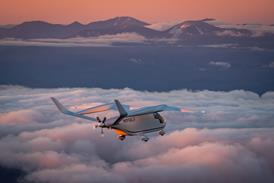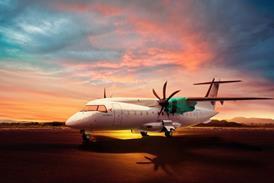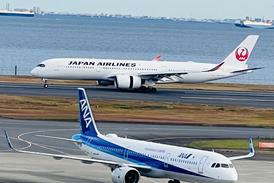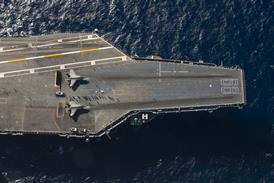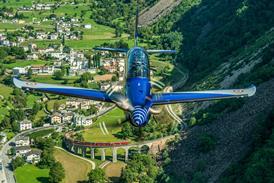C-5 GALAXY
An improved, version of the Galaxy, the C-5D was proposed by Lockheed Martin as an alternative to the MDC C-17, under the USAF's Non-Development Airlift Aircraft (NDAA) programme. The C-5D would have new turbofans - GE CF6-80C2s and a two-crew cockpit based on that under development for the C-130J Hercules 2. The upgrade is also likely to be offered to the USAF as part of a life-extension option for its aircraft.
C-130 HERCULES
The first flight of the Lockheed Martin C-130J was made in April 1996, some five months later than originally scheduled. The UK has ordered 25 stretched C-130J-30s, with options on five more. Deliveries are to begin in 1997. The USAF has ordered two standard-length C-130Js for test and evaluation, with substantial additional orders to follow. Australia has ordered 12 C-130J-30s to replace it C-130Es, with options for a further 24 and an additional eight on option for New Zealand.
The Hercules 2 is powered by four 3,400kW Allison AE2100 turboprops driving Dowty six-blade composite propellers, providing 29% more take-off power and 15% greater fuel efficiency than the C-130H's Allison T56s. The C-130J has a reduced-workload two-crew cockpit based on head-up and flat-panel displays and integrated digital avionics. Tanker, airborne-early warning and maritime-patrol variants of the C-130J are planned. The AEW version would have the Lockheed Martin APS-145 radar, with rotordome antenna.
Deliveries of the present C-130H/H-30 will end in September 1996, after which only the C-130J will be produced
Customers (including L-100 and secondhand aircraft): Abu Dhabi 6, Algeria 22, Angola 2, Argentina 8, Australia 36, Belgium 12, Bolivia 3, Brazil 19, Cameroon 3, Canada 44, Chad 2, Chile 2, China 2, Colombia 2, Curaçao 1, Denmark 3, Dubai 2, Ecuador 4, Egypt 26, Ethiopia 2, France 14, Gabon 5, Germany 1, Greece 12, Indonesia 28, Iran 64, Israel 12, Italy 14, Japan 15, Jordan 4, Kuwait 6, Libya 16, C-130H: Malaysia 14, Mexico 1, Morocco 19, Netherlands 2, New Zealand 5, Niger 2, Nigeria 9, Norway 6, Oman 3, Pakistan 6, Peru 8, Philippines 5, Portugal 6, Saudi Arabia 59, Singapore 6, South Africa 7, Spain 13, Sudan 6, Sweden 8, Taiwan 16, Thailand 8, Tunisia 2, Turkey 8, UK 66, USA 1,282, Venezuela 8, Yemen 2, Zaire 6, Zambia 3, C-130J: UK 25, USA 2.
C-141 STARLIFTER
Operating restrictions on the USAF's 244 C-141B transports were lifted at the end of 1994 following completion of wing repairs. Aircraft are to be upgraded by AlliedSignal and Chrysler Technologies Airborne Systems with new digital autopilot and flat-panel cockpit displays. The C-141 is to be replaced by the MDC C-17.
F-111
The EF-111 will remain in service until 1999. Rockwell is upgrading 18 F-111Cs and four RF-111Cs for Australia, which has also bought 15 ex-USAF F-111Gs (formerly FB-111As) to keep the fleet viable through to 2020.
P-3 ORION
Delivery of eight P-3C Orion Update III maritime-patrol aircraft to South Korea was completed in 1995 and the company now has no further customers for the type. The company may continue to market the Orion 2000, with Japan a prospect, despite not winning an order
The Orion 2000 is powered by 4,500kW Allison AE2100 engines driving six-blade composite propellers and giving increases of 27% in take-off power and 10% in payload. The aircraft would have a two-crew cockpit, new mission avionics connected by a fibre-optic digital data network, expanded weapons capability and system improvements. The USN intends to keep 247 P-3Cs in service until 2015 before a replacement aircraft begins to enter service.
S-3 VIKING
Production of the carrier-borne S-3 has ended, but the USN plans to keep the maritime-patrol aircraft in service to 2015. The Navy upgraded 121 S-3As to S-3B standard, with enhanced acoustic processing, expanded ESM coverage, improved radar, a new sonobuoy-reference system and Harpoon missiles. A further 16 S-3As have been extensively modified to ES-3A electronic-warfare/reconnaissance aircraft. Further upgrades are planned.
Source: Flight International

